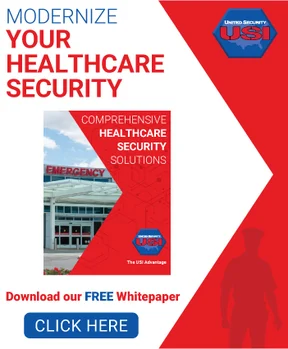The Pressures Healthcare Facilities Face
Hospitals and care centers operate in one of the most complex environments for security. Leaders must keep facilities open and welcoming to patients and families while also protecting staff, assets, and sensitive information. That balance has never been more difficult to achieve.
Workplace violence is rising. Healthcare workers are five times more likely to experience workplace violence than workers in other industries, according to the U.S. Bureau of
Labor Statistics. Incidents create trauma for staff and disrupt patient care.
Cyberattacks are growing more damaging. Ransomware targeting hospitals nearly doubled in recent years, delaying treatment and putting patients at risk. Patient-sensitive data like medical records, histories, and billing remains a top target for cybercriminals.
Resources are stretched thin. Staffing shortages and limited budgets mean hospitals often have to do more with less, leaving gaps in safety programs that criminals or crises can exploit.
These pressures show why healthcare security must be more than coverage. It requires integration, coordination, and a culture of care.
When Seconds Matter: The Human Side of Security
Security officers often provide the first response when something is wrong. Recently, one of our officers, assisted a patient arriving at the emergency department. After helping with a wheelchair, he immediately recognized the patient’s distress and alerted the medical team. Because he spoke up, the patient was quickly treated for a cardiac emergency.
“This officer should be recognized for supporting a culture of safety. It can be intimidating to speak up in front of medical professionals, but in this case, he did exactly what was needed. His actions helped the care team respond quickly, and the outcome was a success.” - Healthcare Client
Moments like this show the human impact of security officers. They are not only protecting spaces, they are supporting patients, visitors, and staff in ways that directly affect care outcomes.
Core Concerns in Healthcare Security
Healthcare leaders consistently cite several areas of focus:
Workplace violence: De-escalation training, officer presence, and coordinated response are essential to protecting staff.
Unauthorized access: Facilities need to balance open access with protection of restricted areas such as EDs, pharmacies, and behavioral health units.
Theft and diversion: Medications, equipment, and even patient property are at risk without layered protection.
Cybersecurity: Patient data and connected medical devices must be secured to maintain compliance and, more importantly, patient trust.
Addressing these issues in isolation is no longer enough. Physical, technology, and cybersecurity must work together.
Executive Protection in Healthcare
Healthcare leaders and executives face increased visibility and risk. High-profile physicians, administrators, and board members are sometimes targeted by workplace tensions or public controversy. Executive Protection (EP) services help safeguard leadership, ensuring continuity of operations and peace of mind for those making critical decisions.
The rise of EP in healthcare reflects a broader reality: security threats don’t stop at the facility entrance. They extend to people, reputations, and operations.
Why Integration Matters
The safest healthcare facilities take a layered approach to security. Physical officers provide presence, response, and support for staff and patients. Security technology adds visibility through cameras, access control, and real-time monitoring. Cybersecurity protects sensitive data and ensures the systems that support care remain reliable.
When these three layers work together, security is stronger and more resilient. Physical incidents can be supported by real-time video and access data. Technology systems are protected by cyber defenses that keep them secure and operational. And officers on the ground can act quickly with the confidence that both the digital and physical infrastructure behind them is sound.
Integration creates a complete picture of safety — protecting people, property, and information with one coordinated approach.
Why Partner with USI
Many providers offer guards or cameras. What sets USI apart is how we deliver these services with healthcare in mind:
Specialized Healthcare Expertise
Our officers are trained to operate in clinical environments with professionalism, compassion, and respect.
Integrated Security Approach
We bring together physical security, technology, and cyber in one coordinated program — reducing complexity and strengthening outcomes.
Culture of Care and Action
Our officers represent a culture of care and accountability. We empower our teams to speak up, act quickly, and support healthcare staff, not simply fill posts.
Proven Partnerships
With decades of experience, we’ve built long-standing relationships with healthcare providers who rely on us for stability and trust.
Building Safer Facilities Together
Security in healthcare is more than protecting property. It’s about protecting people, supporting clinical staff, and enabling care to take place with confidence. By addressing workplace violence, integrating cyber protections, and offering specialized services like Executive Protection, USI helps facilities meet today’s challenges head-on.
We see healthcare security as a responsibility, one that requires professionalism, compassion, and a commitment to those who give and receive care every day.

.png)
